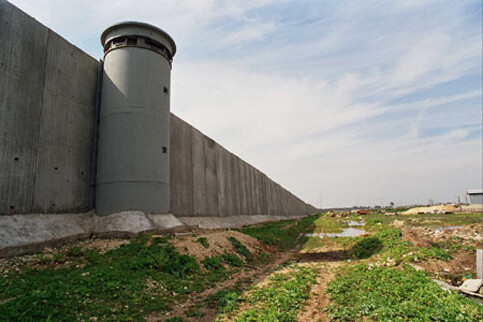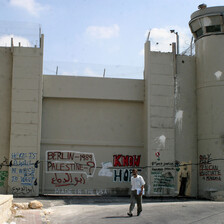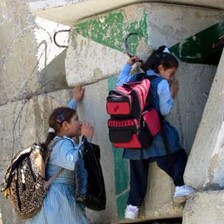The Electronic Intifada 18 August 2003

The wall near Qalqiliya. (PENGON)
Here in Palestine we have been watching with great despair the visits of Palestinian Prime Minister Abbas and Israeli Prime Minister Sharon to Washington. Amidst the rhetoric of negotiations, over 100 bulldozers are working non-stop, every day, to continue construction of the Wall, which highlights the actual path that the Road Map is paving. While President Bush was correct in calling the Wall “a problem” and referring to it as “a wall snaking through the West Bank,” on the ground there is no sign of an end to what has been called the largest “project” ever undertaken by Israel.
In this context, the negotiation process seems void of any meaning, or a smokescreen for what is being implemented on the ground.
Expected to be the largest land grab since 1967, the year Israel occupied the West Bank and Gaza Strip, current projections suggest the Wall — with an expected length of 400 miles — will solidify Israeli control of almost one-half of the West Bank. The Wall is already snaking its way up to 4 miles inside the West Bank, and in some areas may cut 10 miles into the West Bank. It consistently follows a path that ensures maximum settlement annexation and large-scale control of Palestinian lands.
The Wall (misleadingly referred to as the “security fence”) takes on a number of horrific constructs. In some areas, it consists of an 8 meter (25 feet) high concrete edifice with armed watchtowers hovering over residential areas. In others, the Wall is layers of electric fences and buffer zones of trenches, patrol paths, sensors and cameras. Whatever the structural differences, the effect is the same.
Life in these open air prisons is intolerable. Palestinians will be imprisoned in walled ghettos, deprived of the most basic human rights. Such oppression and misery are already taking hold in the areas where the Wall is currently being built. Some 10% of the West Bank is already affected by the destruction created by the Wall’s “first phase.” Building the Wall has involved razing agricultural land, damaging irrigation networks, isolating water resources and demolishing homes, stores and community infrastructure. With the daily subjugation of closures, sieges and curfews, people have become particularly dependant upon their lands for mere survival, but they are unable to access them. The fertile lands of 51 villages have been either confiscated or isolated and unreachable because of the Wall.
The latest opening of three “crossing points” — in addition to dividing Palestinian lands — only further highlights the institutionalization of the land theft of the Wall. In less than a month since the gates were opened, people have been shot, beaten, humiliated and prevented from accessing their lands. Such scenes are a part of the daily Palestinian landscape under Israeli Occupation and around the Wall. This Wall and its so-called ‘crossing points’ are inhuman and illegal.
For us, and for all who have witnessed what is taking place, the Wall is nothing less than a collective noose around the Palestinian areas and the Palestinian people. In Qalqiliya, where Wall construction is nearing completion, close to 15% of its 41,600 inhabitants have been forced to leave, unable to survive in what many in the community call “the Apartheid Cage”. In Palestine, and among various solidarity groups, the Wall is referred to as the Apartheid Wall — part of a colonial project that embodies within it the long-term policy of occupation, discrimination, and expulsion.
The Wall is to guarantee that a free and sovereign Palestinian state will become impossible. Consequently, the recent usage by Israeli Prime Minister Sharon and US President Bush of the terms “viable” and “state” take on particularly cynical and empty meanings. Their increased calls for a “state” run in direct parallel with the impossibility of such a state existing, as the sealing of the fate of the Palestinian people into ghettos of the dispossessed takes hold.
In Palestine, the demand to stop the Wall is in the forefront of calls being made by the public. We ask that you join us in this urgent call.
Jamal Juma’ is Coordinator of the Palestinian Environmental NGOs Network [http://www.pengon.org], which is leading the Anti-Apartheid Wall Campaign, a Palestinian NGO and grassroots effort calling to stop the Wall. The Campaign will be releasing an English-language book on the Wall on August 1 titled The Wall in Palestine.




